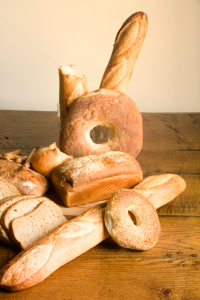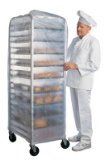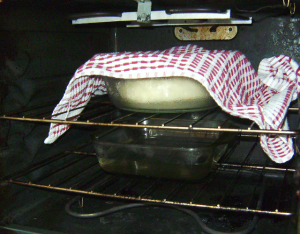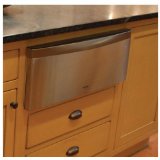 The most common problem in public school culinary classes is finding unique ways to proof & bake yeast doughs given a series of different challenges such as:
The most common problem in public school culinary classes is finding unique ways to proof & bake yeast doughs given a series of different challenges such as:
- 50 minute classes- too short to complete yeast breads in one shot
- Alternating block schedules- you have longer classes but only see your students every other day
- Having to plan yeast bread lessons around weekends so the dough doesn’t sit all weekend
- Having a class first thing in the morning- not having time to warm up or proof the dough
- Lack of a proofing cabinet (affiliate link)
- Lack of a steam injecting oven- special steam injection expensive ovens is what makes bakery breads turn out with such a beautiful crust
What happens if you don’t have enough time to Proof dough?
- You can refrigerate the dough over night which slows down the fermentation process but still allows the dough to rise and bake it the next day. This is process is called retarding the dough. The longer proofing time increases the flavor of the doughs making them taste more yeasty.
How long should I proof? How long is too long?
- The typical test to see if yeast bread has proofed long enough is the poke test. You simply poke the dough and if it springs back right away it is has not proofed long enough.
- Over proofing your dough is possible if you let the dough ferment too long. Baking over proofed dough will give you finished product that has lots of tunnels (air holes), a lower loaf volume, and less oven spring.
What if you don’t have a proofing cabinet? Create your own!
- Microwave a mug of water for 4 minutes until it is boiling. Move cup to the side of the microwave and add dough to the microwave and close the door.
- Baking Rack: Take sternos and place them on bottom of baking rack. Place tray of water above sternos. Put dough on sheet pans in baking rack. Cover with plastic cover.

- Fill a 13 X 9 pan full of boiling water. Place on lower rack of your oven. Put dough on rack above the water. Close oven door.
- Turn your oven light on then put your dough in the oven and close the door. This creates a draft free proofing box with some heat coming from the oven light.
- If you have a warming drawer you can use that or an oven on very low heat (75F).
- Turn your oven on the lowest heat like 175F for five minutes then shut it off and open the door for 3 minutes. Put your dough in and shut the door. Some of the heat will be trapped in the oven but not too much to start baking the dough.
What if you don’t have a steam injecting oven? Create your own!
- Home ovens vent therefore they don’t trap the steam inside. Ideally you could figure out how your oven vents and cover the venting mechanism to keep the steam created by the methods below in your oven. (Please use caution when attempting this method).
- You can also use Combi Ovens (affiliate link) for steam injection. If you don’t have one put one on your list for the next culinary room renovation or grant- they are great!
How to create steam in a home oven:
- Throw ice into the bottom of a hot oven to steam the dough as the ice melts.
- Fill a 13 X 9 pan full of boiling water. Place on lower rack of your oven. Place your dough on the rack above the hot water.

- Spray your dough using a spray bottle, with a mist of water before dough goes into oven.
- Spray the dough and oven walls with water periodically throughout baking. (Note: Be careful not to spray cold water on the light bulb of your oven or it could shatter).
What are some ways to deal with schedule issues and still have my students make yeast breads?
- If your school runs on a period schedule with 8 periods a day and 50 minute classes, why not explain & demonstrate yeast breads in class and assign the making of yeast bread for homework. The King Arthur Bread Baking Program does this for elementary & middle schools across the country.
- If you have classes back to back that are all doing the same lesson it is possible to have the first class make the dough and let it begin to proof then have the next class shape and bake the dough, etc. The last class that day would make dough for the first class to shape since they only made dough the day before but didn’t get to bake it.
- Have a culinary aid or lab assistant make enough pounds of dough for each group. Have your students start by making the dough then use the prepared dough that has been proofing to shape and bake. Have another class or lab assistant bake all the extra dough that the class made and sell it to the faculty.
- If you see your students every day proofing in the refrigerator is the easiest way to go.
- If you have block scheduling you can have your students scale out all the ingredients one day then mix, knead and proof the dough the next. If they can work fast enough to get the bread ready to bake you can bake them all for them and the students can eat their bread when you see them again.
- Have your students make the dough in class then stick it in the refrigerator to proof. Have your students come back at the end of the day to finish making it at home.
- On the same lines of homework, it is also possible that if you see your students only every other day to do a demonstration on yeast breads and the mixing & kneading portion, have each student scale the ingredients, and then assign your students to make the dough at home the night before class, pop it into the refrigerator overnight and bring it to class to shape and bake. This prevents over proofing the dough- which would result if you keep the dough in the refrigerator for two days until you see your students again.
- One of my students actually suggested that I have them come in during lunch to finish shaping the dough. This works in my case because I see them first thing in the morning, so by lunch it is time to shape the dough.
- Along the same lines, you could have your students come in and finish after school.





1 comment for “Yeast Bread Conundrums”